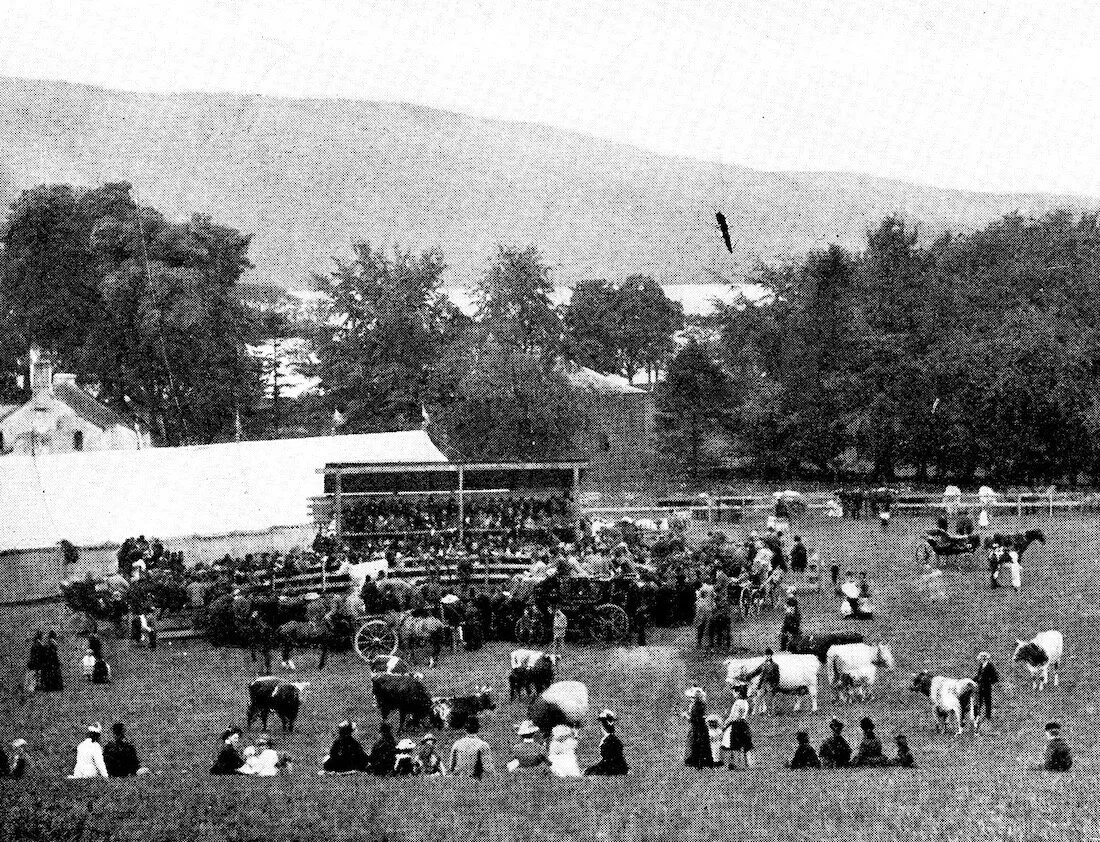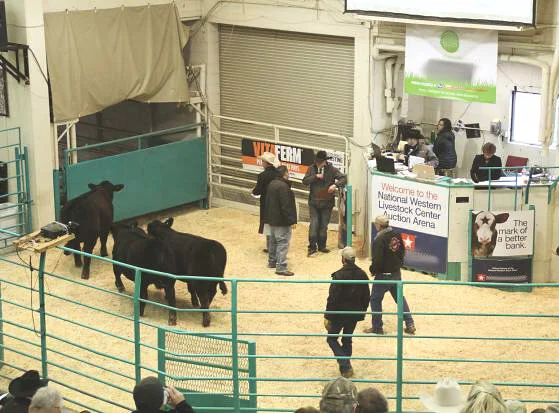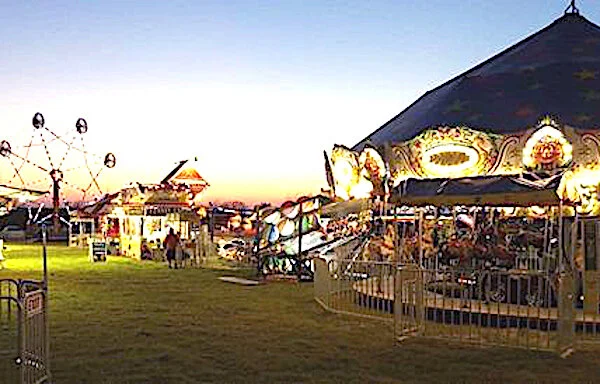Farm Update
Here in Oregon we are going through the worst drought we have ever had. It has not rained for about 3 months and temperatures topped out at a 117 F this summer. We had to start feeding hay in the middle of July when normally we would not start until sometime in September. There has been some impact on fertility in the cows but we now have most of them bred back. Hopefully the drought breaks in the next month and we get back to a normal weather pattern. Fortunately we have not had any major fires in our area so that has been a plus.
Whispering Hills Farm Heritage Shorthorn cow: Whisper Bernice. She is a 3 year old that weighs about 1750# and is sired by Whisper Royal Chief (a Meadowbrook Chieftain 9th son). She had a bull calf this year sired by Great White Hope.
Quarterly Topic: Thoughts On Cattle Shows And Sales
Full Disclosure
Having the good fortune to attend cattle and sheep shows/sales around the world over the last 44 years has provided me with clarity on how most shows and sales are conducted. I quit showing livestock in 1991 because of my disgust with what I thought was a rigged system that was leveraged against the smaller, unknown livestock breeder which resulted in the selection of show winners that often had no relevancy to real world livestock production systems. I have never purchased an animal at a sale because I do not believe in the artificiality that accompanies the way sale animals are “prepped” for the sale nor do I condone the lack of sale transparency that should exist.
History
Livestock Shows and Sales were a large part of the cattle industry even before Shorthorns became a breed around 1800. The local fairs and sales at the beginning of the livestock industry played a pivotal role in breed improvement because they were a gathering place where animals could be viewed and ideas exchanged. They have played a major role in the evolvement of Shorthorns in both good and bad ways. A salient bad example were the Belt Buckle (semi-dwarf) Shorthorns that were promoted from the 1940’s to the mid-1960’s. A positive example would be the selection of larger Dual Purpose Shorthorns to “reshape” Shorthorns from the mid 1960’s to the early 1980’s.
Historically most seedstock cattle breeders have participated in shows and production sales to increase both their herd’s visibility and their access to a wide variety of buyers. This “business model” has been the backbone of the cattle seedstock industry but it is in the process of changing. Many readers are familiar with “the games” that are played at shows and sales. This article is geared more toward the new breeder who may be trying to decide whether to buy at a sale or purchase through private treaty perhaps after attending a show.
Shows
There are many types of shows from those at the local level to regional and national shows. For the novice breeder these shows offer an opportunity to observe the phenotype that is currently in vogue within a particular breed and to meet a broad range of show participants. Unfortunately this may skew the viewpoint of the novice because “show cattle” do not necessarily guarantee quality cattle that will fit their needs. It can be maddening to try to follow the thinking of many judges at shows because there may be subjective rather than objective reasons for their placements in individual classes. Subjective reasons may include friendships, past buyers, particular bloodlines, past show performance etc. It is extremely important to realize that the statement that “it is one person’s opinion” holds true. Ultimately every cattle person needs to formulate their own opinions about what constitutes a good animal versus a mediocre animal for their own herd.
Show participants
There are four types of show participants:
First are what I call the “Ribbon Chasers”. They just want to win regardless of the cost. If that means buying an animal from the judge or employing professional fitters and showers to achieve their goal then so be it. They “farm” their animals out to professionals in the pursuit of winning and spare no expense in trying to achieve that goal.
Second are longtime seedstock producers who have experienced the ups and downs of both shows and sales. They understand the nuances that go into winning shows and having high dollar sale cattle. They understand how the “game is played” and take a more philosophical approach but they also pull out all the stops to win in the show ring and the sale ring.
Third are what can be called the “financially challenged” in the sense they do not have the funds nor the name familiarity to be any more than moderately successful. Many smaller breeders fit into this category but may continue to show and sell through sales because they enjoy the experience and camaraderie. For some it may be more of a hobby but it still contributes to the overall well being of the breed.
Fourth are the “newbies” who are all excited about their prospects and filled with optimism that they can be successful. Most will soon learn the reality of the show and sale rings. Many will give up (most purebred livestock operations do not last more than five years) because they have no chance to successfully compete in the show and their sale cattle will bring low prices because they do not have name recognition and pumped up pedigrees. They become discouraged and “move on”. This is an unfortunate development because it diminishes the chances for new breeders to build quality herds and to become long-term engaged cattle breeders.
How Shows Often Work
Because most judges have familiarity with the breed they are judging they also know who the “big-time” breeders are. They know who the professional fitters and showers are and often give deference to them through show placement. I would like to say “politics” never play a role in cattle shows but it does. It is fair to say that politics often is the difference between winning and losing at many major shows. Fortunately local shows using outside judges may be less political and more fairly evaluated. Many judges own the breed of livestock they are judging so they may be selecting animals that trend toward their bloodlines. Lastly breed types are continually changing because seedstock producers invariably need “new models” to promote just like Ford and Dodge. The disasters which judges have created throughout history by selecting inferior animals that conform to the fad currently being promoted by name breeders and breed associations could fill several books.
How Sales Often Work
At times the subtlety of the sale ring is even a mystery to seasoned buyers. Gullibility and crowd dynamics play a major role in how successful most sales are. I see two big negatives in how sales are conducted. First the preparation of the animals. The animal in the sale ring has been showered with feed, confined, and managed under artificial conditions. Frequently this leads to a big disappointment when the animal gets to its new home and underperforms in the real world. This is particularly true with bulls. The second issue is the lack of transparency. It is extremely difficult to know when a bid is real because of “sleight of hand”. You don’t know if the bid is fictitious ie: a support bid from the seller’s friend, or if the auctioneer and ring people are trying to entice the last penny out of the buyer. There is simply no way to know what the truth is in a “properly” conducted auction.
The Future: Changing Times
There is a real question as to whether livestock shows will exist in the future. Their persistence will be dependent on costs, regulations, breeder support, and public perception all of which are currently trending negative. This trend has been exacerbated by the recent Covid-19 problems. Costs to participate in livestock shows have been rising steadily for a long time, and for many owners, they have reached a tipping point unless they are rich “Ribbon Chasers” or premier show stock breeders. Even some of those people are backing off. It should be said that not all fairs and cattle shows will return following the difficulties of last year, thus further reducing the cost effectiveness of showing. Fairs in many parts of the USA are no longer about livestock as they morph into glorified entertainment carnivals trying to compete with the increasing number of alternatives available for people to spend their entertainment dollar.
Detailing all the regulatory changes affecting the cattle industry would encompass a long list but suffice it to say that the animal rights movement, along with poor decisions regarding show standards, are making more people cognizant of the artificiality of show prepping. How someone can morally justify keeping a cow/heifer/steer in a cold temperature regulated environment for months on end to simply get longer hair growth, that can then be used through trimming, to hide that animal’s faults is beyond me.
Almost all cattle sales in the future will be online simply because of cost and convenience factors. I believe that online sales are positive for sellers and negative for buyers. Sellers reduce costs across the board and can use video/pictures to project their cattle in the most positive light reducing buyer scrutiny. Buyers lose the “hands on” evaluation that has been an integral part of cattle evaluation and sales since time immemorial. With the loss of this tool, buyers can no longer assess cattle with the same rigor nor can they solicit advice/opinions from other buyers that would be at the sale. That personal interaction is often the difference between a good versus bad purchase decision.
As Shorthorns try to hold on to their small piece of the “cattle pie” the deck may be stacked against them given the emerging dynamics of shows and sales. All is not lost though because the elegance and practical attributes of good Shorthorn cattle will likely help stabilize the Shorthorn breed in spite of all the current challenges which the cattle industry faces. The ultimate fate of Shorthorns resides in the nimbleness and determination of non-show Shorthorn breeders in exploring and developing new markets for their Shorthorn cattle.
Future Topic: I Wonder Where Shorthorns Lost Their “Mojo”?
Joseph Schallberger, DVM, PhD
Whispering Hills Farm
Member Academy of Veterinary Consultants




